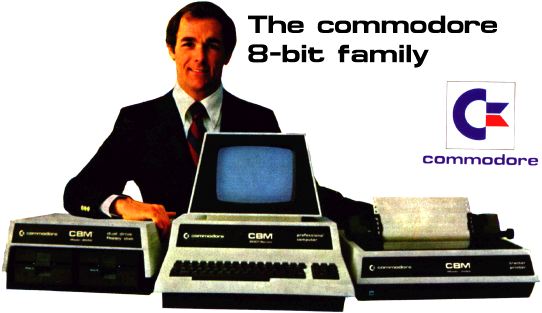Table of Contents
COMMODORE 8-BIT COMPUTER FAMILY
MOS Technology KIM-1 (1976)
 1k RAM - 7 digit LED display - 23 key keypad
1k RAM - 7 digit LED display - 23 key keypad
Not truly a “Commodore” computer, the KIM-1 paved the way to Commodore computing as many of its design elements found their way into the Commodore PET
commodore PET 2001 (1977)
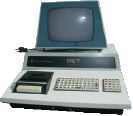 4 or 8k RAM - 40×25 monochrome display - 73 key keyboard - Integrated tape drive
4 or 8k RAM - 40×25 monochrome display - 73 key keyboard - Integrated tape drive
Commodore enters the personal computer market with the first all-in-one home computer integrating the computer, keyboard, display and storage into one compact case (for its time).
Original retail was $595 dollars.
commodore PET 2001-8,16,32n CBM 2001-8,16,32b (1978)
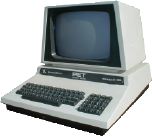 8, 16 or 32k RAM - 40×25 monochrome display - 74[n]/73[b] key keyboard
8, 16 or 32k RAM - 40×25 monochrome display - 74[n]/73[b] key keyboard
After many bug fixes the PET gets an overhaul - a more expandable motherboard, new full-sized keyboard (at the expense of the tape drive), 'upgrade' BASIC ROMs now include disk drive support. Two models exist, the CBM (b) series with business keyboard and the PET (n) series with graphics keyboard. Starting price for the 8k versions $795.00.
(later models would come with 4.0 BASIC and be labeled also the 4000 series - see below)
commodore CBM 8008, 8016, 8032 (1980)
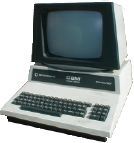 8, 16 or 32k RAM - 80×25 monochrome display - 73 key keyboard
8, 16 or 32k RAM - 80×25 monochrome display - 73 key keyboard
commodore introduces a more business-like PET model in spring 1980, the 8000 series, again with a newer motherboard to support the more flexible video controller driving the new 12“ display as well as integrated piezo speaker for sound. Also introduced with the 8000 is BASIC 4.0 which adds new disk commands, and display features. $1,495 Retail.
(Later an optional add on will allow for an extra 64k RAM to be utilized.)
commodore PET 4008, 4016, 4032 (1980/1)
 8, 16 or 32k RAM - 40×25 monochrome display - 74 key keyboard
8, 16 or 32k RAM - 40×25 monochrome display - 74 key keyboard
Essentially the 8000 series machine with the video adjusted to 40×25 and using the graphics keyboard. Conversion to 8000 series only requires the adding of extra video RAM and a replacement boot ROM. Initial Price $999.00
(some remaining 2001 machines were also baged as 4000 series due to the 4.0 ROMs, though they aren't expandable to 8000 series)
commodore SuperPET or MicroMainFrame (MMF) (1981)
 96k RAM - 6502 & 6809 MPU - 80×25 monochrome display - 73 key keyboard
96k RAM - 6502 & 6809 MPU - 80×25 monochrome display - 73 key keyboard
Based on the 8000 design this machine was deveoped in part by the computer department at Waterloo University in Toronto, Canada. The SuperPET supports dual processors, several character sets, and can operate as a 6502 or 6809 based computer, in 6809 mode several languages can be loaded from disk (BASIC, APL, FORTRAN, Pascal, COBOL, 6809 Assembler) also added was a true RS-232 port for connection to IBM mainframes for language development. Initial retail price $2,000.
(the 8000 series has an upgrade option package to make it a SuperPET)
commodore VIC-20 (1981)
 5k RAM - 22×23 8/16 color video output - 3 voice sound - joystick port - 66 keyboard
5k RAM - 22×23 8/16 color video output - 3 voice sound - joystick port - 66 keyboard
Commodore recognising the opportunity in a low-cost home/games computer and wanting to get the jump on Japanese computers, introduces the first 'under $300' color computer.' included PET BASIC and character set as well as hi-res features, three voice sound, a cost reduced drive/printer interface and RS-232 compatibility with an adapter. Despite it's limited memory the VIC-20 became a popular computer with many expansion options available including the first under $100 modem. Original Retail Price: $299.95.
commodore UltiMax (1982)
 4k RAM - 40×25 16 color video output - 3 voice audio sythesiser - 66 keyboard
4k RAM - 40×25 16 color video output - 3 voice audio sythesiser - 66 keyboard
The UltiMax intended as a video games machine w/membrane keyboard, it only saw limited production and release, a younger brother to the vastly popular Commodore 64. Many believe it was available only in Japan.
commodore 64 (1982)

 64k RAM - 40×25 16 color video output - 3 voice audio sythesiser - 66 Keyboard
64k RAM - 40×25 16 color video output - 3 voice audio sythesiser - 66 Keyboard
The 64, holds the distinction of being 'the 'most sold single computer model ever' with 20+ million units. Commodore made in this compact package (which resembles a VIC-20 case) an all around good home computer with hi-res graphics and sound that were better than most competitors, built in BASIC, and easy interfacing. Along with its winning features and low price and Commodores' international marketing, the 64 held the home market for many years seeing many of it's competitors fall in competition. The 64 popularity allowed it a very long life with several case re-designs, and configurations, but the same functionality. The variations included the 64c a streamlined case more resembling the Commodore 128, the SX-64 a portable unit that included a built-in floppy drive, Educator 64 which is a 64 in a PET cabinet, as welll as the 64GS a keyboardless games console released in europe. Initial retail price: $5.95.
Even today the 64 lives on as a popular computer emulation for today's PCs.
commodore B and P Series (1982)
 B-128/B256 128k-256k RAM - 80×25 16 monochrome video output - 3 voice audio sythesiser - 94 keyboard
B-128/B256 128k-256k RAM - 80×25 16 monochrome video output - 3 voice audio sythesiser - 94 keyboard
P-128/P-500 128k RAM - 40×25 16 color video output - 3 voice audio sythesiser - 94 keyboard - 2 joystick pts.
The B and P series were the next generation of the PET line with memory banking like in the later PETs, they also had the option of using an 8088 co-processor to run CP/M 86 and early MS-DOS applications. The P series had an extremely short life and the B series did well in Canada and Europe where a few variations were made.
commodore 264 Series: commodore 16 and Plus/4 (1984)

 Plus/4 - 64k RAM - 40×25 121 color video output - 4 voice sound - 67 keyboard
Plus/4 - 64k RAM - 40×25 121 color video output - 4 voice sound - 67 keyboard
C-16 - 16k RAM - 40×25 121 color video output - 4 voice sound - 66 keyboard
The 16 and Plus 4 were cost-reduced computers intended to fill in the gapes in the educational and small home/office market that the 64 or B series wasn't. The two machines used a less elaborate video and audio system which afforded some extra text effects and greater color depth, although using essentially the same interfacing for cassette and joysticks commodore used non-standard connectors (possibly to speed them into production). The Plus/4 also included four built-in applications (of limited capability) that could be used without loading any programs. Though these machines floundered in the U.S. in other countries they did quite well.
commodore PC-128 (commodore 128 or C128) (1985)

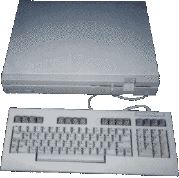 128K RAM - 6502 and Z80 MPU - 3 voice audio sythesiser - 92 keyboard - 40×25 16 color video output or 80 x 25 RGBI video
128K RAM - 6502 and Z80 MPU - 3 voice audio sythesiser - 92 keyboard - 40×25 16 color video output or 80 x 25 RGBI video
Commodore learned a lesson with the plus/4: the consumer wanted MORE, not less, and with that the 128 was deviced. The 128 operated in three configurations, as a Commodore 64, a 128k 6502 machine with a more advanced BASIC and up to 2 mghz speed., or as a Z-80 CP/M computer. The 128 sold several million units as well as later offered an all-in one 128-D unit with integrated floppy drive.
commodore 64 DTV (direct-to-tv) joystick (2004)
Version 1 - US version - 128K RAM, 2MB ROM - 32mghz ASIC emulating 6510 @ 1mghz - 3 voice audio sythesiser - joystick, joystick, 7 butons - 40×25 16 color video output (up to 256 colors)
Version 2 - UK version - 2MB RAM, 2MB flash memory - 32mghz ASIC emulating 6510 @ 1mghz+! - 3 voice audio sythesiser - joystick, 7 buttons - 40×25 16 color video output (up to 256 colors)
After Commodore went bankrupt and closed over the years the fan support for the Commodore 64 never faded, and in some circles kept building. One fan in particular, Jeri Ellsworth who started by working on an improved video device for the old C64 and then later developed it into a n enhanced remake of the 64 using modern reprogrgammable chips (aka the Commodore One or C-One). Holders/Marketers of the Commodore trademark saw an opportunity to use the 64 in the same way other classic games are being packaged into joysticks and had Jeri and friends develop a c64 in a joystick using her new technology.
the Commodore 64 DTV is a nearly complete clone of the C64 with BASIC and adequate wiring to wire in a real (PS/2) keyboard and hook up a Commodore Disk Drive missing is interfacing for cassettes, and a parllel port for hooking in Commodore Modems and such. As sold it is a joystick game capable of plying some 30 or so game titles from the origianl 64, there are “easter eggs” allowing players to drop into BASIC and access some extra titles as well as type on the 64 BASIC via a virtual keyboard via joystick.
Hackers wanting to turn the 64 DTV into a more functional computer can wire in interfaces to add a PS/2 keyboard, Commodore IEC drive port, as well as some parallel port lines (in version 2 a second joystick port can also be wired in).
There is a version 3 DTV but it was not packaged as a Commodore 64 joystick, but a Hummer Off Road Driving steering wheel game, and share many similarities to version 2 (except no second joystick support)
(since it has the official Commodore logo and is truly 8-bit and very compatible I feel it is officially one of the Commodore 8-bits)
almost, but not quite...
commodore LCD Laptop (developed 1985)
 32K battery-backed RAM, expandable to 128K - 65C102 2mghz MPU - no audio - 70 key keyboard - 80 x 16 char built-in B&W LCD (480 x 128 resolution)
32K battery-backed RAM, expandable to 128K - 65C102 2mghz MPU - no audio - 70 key keyboard - 80 x 16 char built-in B&W LCD (480 x 128 resolution)
.
commodore 65 (almost released 1991)
 128K RAM - 8MB- 3.5 mghz MPU - 2×3 voice audio sythesiser - 77 key keyboard - 40×25, 80×25 256 color video output
128K RAM - 8MB- 3.5 mghz MPU - 2×3 voice audio sythesiser - 77 key keyboard - 40×25, 80×25 256 color video output
Commodore was just a few months away to begin full production of this super 8-bitter before they dropped the project., Whith graphics close to the Amiga, dual SID stereo sound (6 voice), a built-in 3.5” drive, and a more advanced BASIC as well -who knows what the home computer market would have been like with this machine on the market. After Commodore's bankruptcy a warehouse of these prototypes were found and sold, many working.

